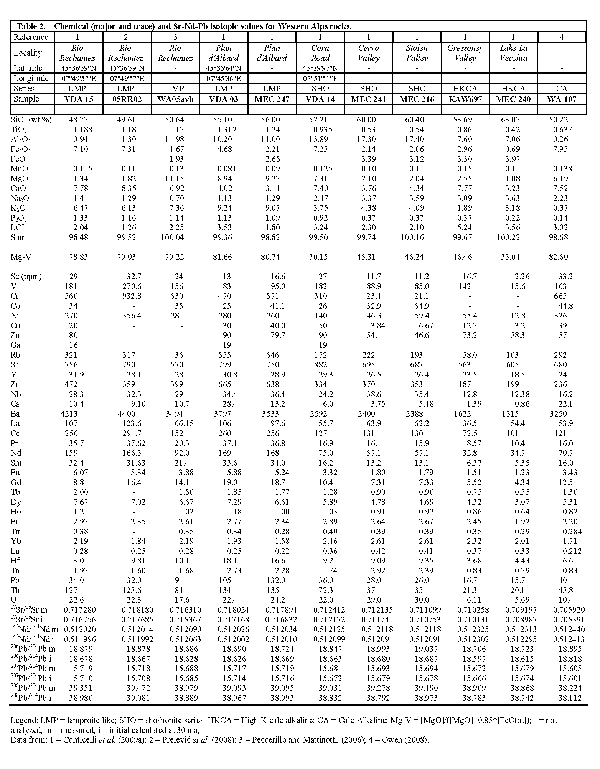Oligocene Magmatism in the Western Alps
Syn to post-collisional magmatism related to the building of the Alpine chain is recorded in the southern portion of the Alps, with emplacement and formation of hypabissal dykes, small plutons and volcano-sedimentary rocks. They are widespread and petrologically diverse with a clear compositional geographical polarity, with tholeiitic to calc-alkaline igneous rocks in Southeastern Alps, high-K calc-alkaline to calc-alkaline in Central Alps, and ultrapotassic, shoshonitic to high-K calc-alkaline in Western Alps (e.g., Beccaluva et al., 1983). Post-collisional ultrapotassic and related shoshonitic to high-K calc-alkaline igneous rocks are found within a restricted area in the internal zone of the North-Western Alps (e.g., Dal Piaz et al., 1979; Callegari et al., 2004; Peccerillo & Martinotti, 2006; Owen, 2008). They are found mostly within the Sesia-Lanzo and Combin Units North of the Canavese Line (Fig. 7). It has been argued that these dykes are the hypabissal manifestation of a more intense volcanic activity, nowday totally removed, witnessed by the occurrence of calc-alkaline to shoshonitic volcano-sedimentary unit in the internal portion of the cover series of the Sesia Zone (Callegari et al., 2004). The Traversella, Valle del Cervo and Biella calc-alkaline plutonic rocks are though to represent shallow level intrusion of the differentiated magmas derived by the calc-alkaline to shoshonitic parental magmas (Callegari et al., 2004).
Figure 7. Distribution of Oligocene ultrapotassic dykes and related sub-volcanic bodies in Western Alps.

Oligocene ultrapotassic dykes and related sub-volcanic bodies occurr in the Western Alps in the area between Val d’Aosta and Piemonte Region and developed in the forms of dyke but some plutonic bodies and volcanoclastics sediments have been also found. Legend: 1) low grade Permian granites and granodiorites; 2) Ivrea zone mafic complex; 3) Ivrea zone knzigitic rocks; 4) Internal Sesia-Lanzo zone (eclogitic micaschists); 5) external Sesia-Lanzo zone (gneiss complex); 6) Schistés Lustrés and ophiolitic complex; 7) Monte Rosa and Gran Paradiso Nappe (orthogneisses); 8) Oligocenic plutonic bodies (T = Traversella; Bi = Biella); 9) Oligocenic volcanoclastic cover series; 10) Pleistocene-Holocene coves. Open squares represent sample localies of the work of Conticelli et al. (2009a). Modified after Dal Piaz et al. (1979); Venturelli et al. (1984); Callegari et al. (2004); Owen (2008); Conticelli et al. (2009a).
The age of the ultrapotassic and related magmatism in the Western Alps has been found to be within the range 34-30 Ma (Krummenacher & Evernden, 1962; Carraro & Ferrara, 1968; Hunziker, 1974), which is coeval with the peak of post-collisional magmatism of the entire Alps (von Blanckenburg et al., 1998).
Ultrapotassic rocks of the western Alps have a lamproitic affinity; they are plagioclase-free micaceous dykes characterised by intersertal textures with phlogopite, clinopyroxene, and K-feldspar, accompanied by minor altered olivine, and riebckite-arfvedsonite amphibole with accessory apatite, sphene, and Fe-Ti oxides (Venturelli et al., 1984). Shoshonitic to high-K calc-alkaline plagioclase-bearing lamprophyric rocks (kersantite to spessartite) are found associated in space and time with ultrapotassic rocks.
The lamproite-like samples have consistently high MgO contents (8.6-13.6 wt. %; Venturelli et al., 1984; Peccerillo & Martinotti, 2006; Owen, 2008; Prelevic et al., 2008; Conticelli et al., 2009a) (Table 2). In the SiO2-K2O diagram (Peccerillo & Taylor, 1976; Fig. 8b) they plot on its top end, within the ultrapotassic rock field with a positive correlation between K2O and silica, but not with MgO (Conticelli et al., 2009a). Shoshonitic rocks have strongly variable MgO content (1.9-10.9; Venturelli et al., 1984; Peccerillo & Martinotti, 2006; Owen, 2008; Prelevic et al., 2008; Conticelli et al., 2009a), which well correlate with silica and K2O. High-K calc-alkaline rocks show also fairly variable MgO (1.1-7.6; Venturelli et al., 1984; Peccerillo & Martinotti, 2006; Owen, 2008; Prelevic et al., 2008; Conticelli et al., 2009a), with data plotting on the potassium-rich basaltic andesite to rhyolite fields. Low-K calc-alkaline rocks have been found by Owen (2008).
Figure 8. Classification and incompatible trace element characteristics of Western Alps Oligocene ultrapotassic and related rocks

Classification and geochemical characteristics of the Western Alps leucite-free ultrapotassic and associated rocks. A) Total Alkali-Silica (TAS - Fields are: 1 = picritic basalt, 2 = basanite/tephrite, 3 = foidite (leucitite, haüynite, nephelinite, kalsilitite, etc.), 4 = basalt, 5 = potassic trachybasalt; 6 = phonolitic tephrite, 7 = basaltic andesite, 8 = shoshonite, 9 = tephritic phonolite, 10 = andesite, 11 = latite, 12 = phonolite, 13 = dacite, 14 = trachyte/trachydacite, 15 = rhyolite) classification diagram (Le Maitre, 2002). For TAS field names see text; B) K2O wt.% vs. SiO2 wt.% classification diagram with reported the grid for orogenic volcanic rock suites (Peccerillo & Taylor, 1976). C) Incompatible trace element patterns for mafic volcanic rocks normalised to the primordial mantle values of Sun & McDonough (1989). Data from Venturelli et al. (1984); Peccerillo & Martinotti (2006); Owen (2008); Prelevic et al. (2008); Conticelli et al. (2009a).
The Western Alps ultrapotassic (lamproite-like) and related rocks are variably enriched in incompatible trace elements, which positively correlate with K2O at almost constant high MgO contents (Conticelli et al., 2009a). These rocks on the Total Alkali Silica diagram (TAS, Le Maitre et al., 2002) align along three different trends at different alkali contents (Fig. 8a), as well as on the K2O vs SiO2 diagram (Fig. 8b). Lamproites have the highest levels of incompatible trace elements, including lanthanides, but with characteristic fractionation of large ion lithophile elements (LILE) with respect to high field strength elements (HFSE). Passing from ultrapotassic to high-K calc-alkaline mafic rocks, through shoshonites, no significant deviations from this behaviour are observed but just a total decrease of incompatible trace element abundances (Fig. 8c). Throughs at Ba, Ta, Nb, and Ti with peaks at Th, U and Pb are the most important characteristics that are typical of the incompatible trace element distributions of orogenic type magmas (e.g. Hoffman, 1995; Hoefs, 2010). Among HFSE it is worthnoting the normalized Ta/Nb > 1, coupled to the normalized Nd/Sr > 1 that inverted to a value < 1 passing from lamproite to shoshonitic and calc-alkaline rocks (Fig. 8c).
